30th May 2011 Brickfields LNR
Well all’s quite at the moment and not much happening. Plenty of juvenile Starlings, Blue Tits and House Sparrows, all breed well over the reserve. I’m also checking out for new juvenile Woodpeckers, as I know they are breeding over there as well. Most of the Spring arrivals are here in the county. I’m now on the lookout for Spotted Flycatchers. No adders sighted yet, but ‘Curly’ the Grass Snake is still about, sun bathing...saw him again today.
Well it always rains on Bank Holidays, well that what it seems to me, but for the first time I’m pleased, we need the rain ! I think I’ll have a barbeque, then it is bound to pour down !
Talking about barbeques...They are not allowed over Brickfields, but sad to report people are having them. This is classed as anti social behaviour. It’s not so much the mess they leave behind, coupled with the obligatory empty cans of lager etc, but the total disregard for the hazardous dangers of fires getting out of control and also putting themselves in danger of accidents without nearby assistance of the emergency services.
Have one at home it’s much better and safer.
Bye for now.
23rd May 2011
When I mean good kite flying weather, I mean the type of kite that’s on a length of string! It’s very windy and my newly planted hanging baskets on taking a battering. However look to the sky occasionally as the other sort of kite..a Red Kite might be about, a couple of sightings have been recorded over the Hornchurch and Upminster area in the last two weeks. This time last year I spotted a Red Kite overhead from my garden in Cranham, circled over Brickfields, then flew off heading northeast. I have not counted it on our bird list, as I only started recording and published this website in February of this year.
The Red Kite is quite distinctive, a large rapture with a forked –tail, displayed when gliding. It would be nice to see one again.
Red Kite in Flight In all my exitement over Adders, I forgot to add a new bird to the list...the Swift...I saw about a dozen fying around at speed feeding, on Friday 20th. You will now see them on a daily basis, best time I find, is late afternoon and early evening.
Another little bird told me that Blue tits have bred in a nest box in Aiden Barrett garden, have a look (without disturbing them), each morning and evening,see how many times the adults come to the nest with food, but don't forget school and homework first !
Hope all go's well Aiden.
22nd May 2011
A following on from yesterday about Adders. The information and yesterdays pictures have been taken from The Surrey Amphibian & Retile Group website. All credits to them. The website is excellent,take a look.
How to see Adders in the wild
The best way to spot Adders is to determine a place where they are known to exist. This may be a local heath, common or even a nature reserve. A useful source of information is the local Amphibian and Reptile Group (ARG).
Be prepared for people to be secretive about Adder sites, as human persecution is, sadly, still a threat to Adders.
Observing reptiles in the wild can be difficult, and lack of sightings after hours of effort is usual for beginners, and can sap the initial enthusiasm. Knowing Adders are present in an area will help morale, and you can use a known site to hone your skills.
Once you have found a site, you must next decide whereabouts on the site is the best place to look. Adders require good dense ground cover, where they can hide from predators, yet also require sunny spots for basking. Adders tend to prefer higher (drier) ground in Spring and Autumn, and will readily adopt dips on a hillside as protection from the wind. South facing slopes are preferred, as sunlight will fall on these areas for more of the day.
Adders are very shy animals and will disappear into cover silently as soon as they detect your approach. Walk slowly and lightly as ground vibrations can be picked up by Adders at a considerable distance. Pause occasionally to scan the edges of undergrowth. Walk with the sun behind your back, so you are looking at the undergrowth along your shadow. This way you will be looking into sheltered basking spots, rather than over undergrowth which obscures sunny positions. Look at the edges of good ground cover (ideally a mixture of deep moss and heather), in direct sunlight.
Although Adders are active in conditions as cold as 6°C probably the best temperature range for spotting Adders is between 9°C and 19°C (48-66°F). Better days will have intermittent cloud cover, as continual sunshine allows the Adder to warm more quickly, and to bask less frequently, and the best chance of spotting Adders is when they are basking. Choosing a morning after rainfall the previous night provides even better chances for spotting Adders, as the dampness in the ground will cool the snake, such that it has to bask to gain the required energy for the day's activity.
Looking at cover close to your feet means that you would have to get very close to an Adder without it spotting you first. Its best to scan the ground-cover at a distance of at least 12 feet (4m) although further is better, scanning ahead and closer alternately, as Adders have excellent camouflage. If possible, walk such that any wind is blowing from the direction you are walking towards, as Adders have an excellent sense of smell, and could otherwise detect your presence.
If you are lucky enough to spot an Adder, remain motionless, and if possible crouch, very slowly, to the ground. Adders are very sensitive to objects moving against the sky, as most of their predators are birds. If the Adder moved into deep cover, and providing it was not unduly disturbed, if you remain motionless, it is likely to reappear within 5 minutes to the same spot to continue basking.
No more about Adders ! until I find one that is !
If you do happen to sight any Adders on Brickfields L.N.R let me know, but most of all please don't harm or harass them.
Bye for now
21st May 2011
I attended the local Ratepayers Association ward meeting on the 12th May and gave an update of the Brickfields L.N.R. I happened to mention that I had regularly see Grass snakes and Slow worms and there were probably also Adders over Brickfields as well. I got the feeling, not all of those attending were happy! I have also mentioned these facts to people who visit as well; sometimes a look of horror is a response. I don’t set out to frighten or to get a shock reaction, but just to show how diverse in wildlife Brickfields is! So there are no Rattlesnakes, Cobra’s or Pythons waiting for you in Brickfields, no more then there are Alligators, Crocodiles and Piranhas lurking in the pond. So here are some facts about the only venomous snake in Britain.
The Adder: Scientific name: Vipera berus
Size: The male is around 60cm long, and the female is approx 75cm
Distribution: Found throughout England, Scotland and Wales.
Months seen: March to October. During the winter adders hibernate underground. The young are usually born around August.
Habitat: Adders are normally found on heathland or sand dunes. They can often be seen warming up their bodies (basking) in the sunshine.
Food: Mice, voles and lizards.
Adders can be recognised: ( see pictures below ) by the dark zig-zag pattern running down the length of their back, and by the dark V-shaped marking on the back of their head.
What people really worry about is being Bitten so......How common are snake bites?
N.H.S facts & figures. Each year, approximately 100 cases of adder bites are reported in the UK. Most bites occur between February and October, with the number of bites peaking during the summer months.
Adder bites can be painful but they are rarely serious. About 7 out of 10 adder bites only result in pain and swelling in the area that has been bitten. Since records began in 1876 there have only been 14 reported deaths as a result of adder bites, with the last death occurring in 1975!!
Adders sometimes bite without injecting any venom (toxins produced by the snake). This is called a ‘dry’ bite and may cause: mild pain caused by the adder’s teeth puncturing the skin, a little more than a wasp sting. If an adder does inject venom when it bites it can cause more serious symptoms including: Swelling and redness in the area of the bite, nausea (feeling sick) vomiting and feeling faint. So seek medical advice at once.
Adders bite in self-defence if they are disturbed or provoked. They don’t go out looking for humans or dogs to bite, in fact the total opposite, they don’t want to been seen or to be attacked. They will just slide away rather then be confronted.
I have not seen any Adders over Brickfields yet...The last one I saw in the wild, was last year, in the grounds of St. Georges Hospital, Hornchurch !
So if you want to find your own Adders, I will tell you how tomorrow !!
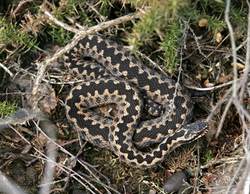 A fairly typical basking position for an adult male Adder. As usual, thick cover is close by the basking spot, in this case a gorse thicket.
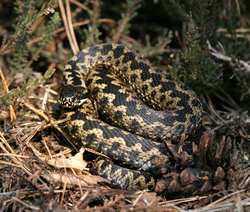 The reward for hours spent searching for Adders can be sight of beautiful animals such as this adult, who was carefully caught and posed for this picture.
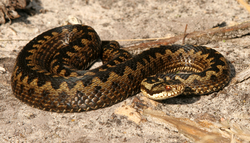 This male Adder has found a last shaft of sunlight for basking as evening sets. This demonstrates how Adders are drawn to direct sunlight.
20th May 2011
Brickfields seems to be a good place to see and hear Cuckoo’s. I have recorded the numbers so far as seven this year, however it’s very difficult as you might count the same one again. But I have seen and heard two within 250yds of each other; the third was calling some distance away, but within my hearing level. My first record was on the 5th May for this year. But other local residents have been hearing them for years! I was very pleased to receive a list of dates of the first cuckoo arrivals from local residents, Steve & Carol who have recorded since 2001...fantastic,
Grateful thanks to Steve & Carol, All credit to them!... Hope you don’t mind me sharing this.
This is the list ;
24/4/2001
16/4/2002
28/4/2003
17/4/2004
2/5/2005
26/4/2006
4/5/2007
28/4/2008
17/5/2009 (latest arrival date)
28/4/2010
and this year 20/4/2011
Great timing don't you think, you can almost set the date by them, except in 2009, when their alarm failed to go off !
Wonder if it was a Cuckoo clock? I am going to check what the weather was like between mid April to mid May '09, because this does effect migration.
Bye for now.
19th May 2011
I've been away again for the week, retirement is wonderful, how did I find time to go to work !
So let’s update a past entry. Back in March I told you about a bird I wanted to photograph, well someone has taken it for me, another local resident, well done and thanks Lindsey! This bird has been around the area of Brickfields for about four years, according to Lindsey. It is often in her garden and this is where the photo was taken. I have seen it about for two years myself, but have never been able to get that close to photograph it.
It's a male Blackbird and has some unusual markings ( see Picture). It has what they call, an Albino gene. It is fairly uncommon, but not rare. There have been some records of Blackbirds being totally white, and that is classified as being a true Albino, which is rare. If this particular Blackbird had white marking on the front, it could be mistaken at a distance for a Ring Ouzel, see the difficulties. Bye for now !
Lindsey's Blackbird Picture Ring Ouzel
12th May 2011 - A Brickfields reply
Hi Steve,
Sorry for the late reply....Yes I would be interested in the cuckoo dates and for any other information or sightings regarding Brickfields. Just as a matter of interest the first Cuckoo heard locally ( that was recorded this year, that is ) was at Rainham Marshes ( R.S.P.B Reserve) on the 12th April and even nearer, at Hornchurch Country Park ( Ingrebourne Valley ) on the 16th April. My first seen & heard was over Brickfields 5th May.
Keep in touch and to anyone else who wishes to make any comments or ask any wildlife questions about Brickfields. I'll try to answer and reply within a few days.
To make a comment, just click on 'Comments'
Bye for now
11th May 2001 Brickfields LNR
Went over about 8:15am, had a look around in search of possible Adders, but a bit overcast, cloudy and not as warm. So they were probably hiding somewhere a bit warmer, having a ‘Duvet Day’ as they say. There will be other times, still only early May!
I stopped at the pond as normal, which is one of my favour spots and watched the regular large Grass Snake swim through the water and up onto a large floating log, just as the Sun come through. The Sun remained on that part of the Pond for about an hour and the snake decided to curl up and make the best of the warm rays. I think I’ll nickname him ‘Curly’.
Found – On Saturday 7th May - a Silver metal Necklace with some charms attached to it was found on the pathway leading from the Car Park in Sunnycroft Gardens to the reserve. If you know anyone who may have lost this item or it may be you! Please leave a message on this page by clicking on ‘Comments’ hopefully the person and necklace can be reunited again!
The Necklace has been handed in at the Corbet Tye Road Police Office and you can contact them on 0207 1618907
Bye for now.
9th May 2011 - Brickfields LNR
On such a lovely day Brickfields is a must. Glad I went, saw a few things which I have seen before, however not over Brickfields! Made my way over to the Pond, it didn’t matter where I looked there was something of interest.
Apart from the Large Red Damselfly, which I recorded last week, there are now several Common Blue Damselfly flitting around. At least six Smooth Newts surfaced from the water for a gulp of air before returning to the depths. A nice Song Thrush came down to have a drink and plenty of Bird song around the pond, Blackcap, Whitethroat, Chiffchaff, Great Tit, even a Green Woodpecker joined in with that laughing Yaffle call. Sitting there nice and quiet and a Cuckoo came over out of nowhere, at first I thought it was a hawk, but it landed a few yards away and called, before taking off again. No doubt it saw me move. Another new Bird for the list, two House Martins flying overhead. Then someone (regulars to Brickfields Sally & Colin with their Dog ‘Sky’) called me over to have a look at something on the path. Well, without doubt a Slow Worm making its way across the path from the Pond area to the undergrowth on the other side. Managed to take some photos. I love them, not everyone’s cup of tea, but totally harmless, they don’t bite, unless you are a slug... see good for the garden, you’re beginning to like them more already! People think they are snakes, but they are not. They are more a ‘Limbless Lizard’.
A quick walk through Franks Wood, not much in the way of Birds, only a couple of Jays, Wood Pigeons, Magpies and Great Tits. The Tree canopy cuts out a lot of the light, but where the Sun can break through it looks lovely. I managed to photograph a nice Red Admiral Butterfly on the fallen leaves on the ground, taking in the nice warm sunshine in such a place. So making my way back home and walking back along the path past the Pond again, another Slow Worm was making the same trip as the one seen previous, defiantly a different one. All I need now is to go looking for Adders to add to the list of species. I have been told by reliable sources that there are Adders over Brickfields and because of the widening of the M25 nearby, a lot more wildlife has been push over to our reserve....Good!
Bye for now
Photographs: 1 & 2 Slow Worm 3. Common Blue Damselfly 4. Red Admiral Butterfly.
5. Franks Wood ( Red Admiral sighted beneath this Tree) 6. Common (Smooth) Newt.
(Click on Picture to enlarge).
8th May 2011 - Brickfields L.N.R
A walk around the reserve at mid-day for a couple of hours, while the Sunday roast was cooking. Look... my wife says I am only in the way!
Three Cuckoo’s encountered, one calling, probably some quarter of a mile away, but I managed to get within thirty yards of another one, really good views through my Bins (Binoculars) oh for a decent camera! The other one flew off when I got within 100yds and lost it as it flew into a wooded area. While trying carefully to walk through the fairly long grass, because I did not want to disturb any snakes having a sun bathe, I nearly trod on a Lizard, who managed to scurry away from my size 9 Boot. I would have liked a better view, but it was too fast for me...most things are these days!
Plenty of Blackcaps, Chiffchaffs and Whitethroats in the wooded areas and look on the tops of Brambles that’s where most of the Whitethroats were sighted. Not sure if it was a Willow Warbler that I heard, didn’t see it, even though it was very close, I’ll try the area again this week.
A few of the Iris’s ( Yellow Iris ) at the edge of the pond ( to the right of the Pond dipping platform ) have now come into bloom, I think when a few more bloom it will make a lovely sight and a good photograph.
Well I don’t often say, “Glad it’s raining’’ but boy do we need it! So a few heavy showers that arrived yesterday were welcome news. The ground is dry, the newly planted trees need a drink and one thing that worries me is a fire! So can it pour of rain please....during the night, when I’m asleep of course.
Bye for now
Cuckoo (male) Common Lizard Iris Pseudacorus
Click to enlarge Photographs
|
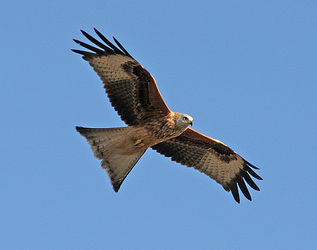
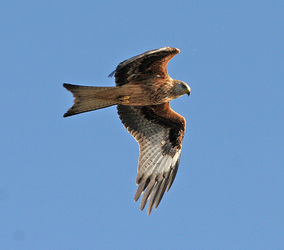



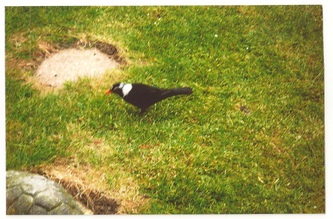
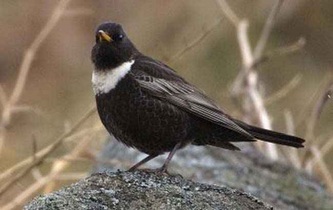
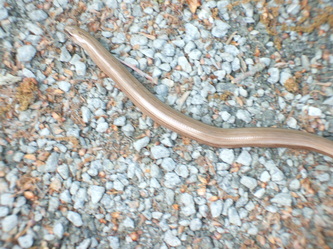
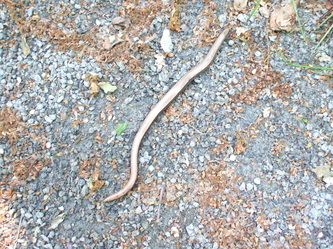
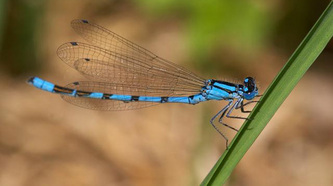
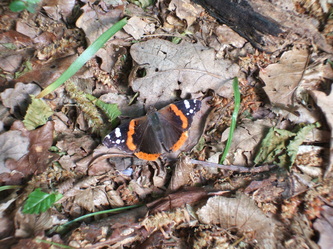
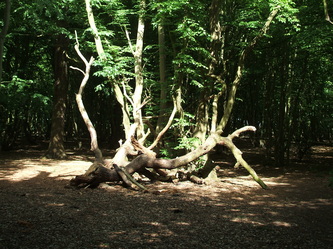
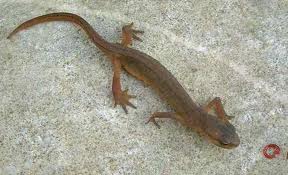
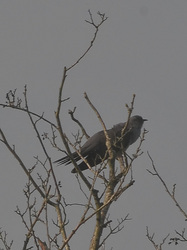
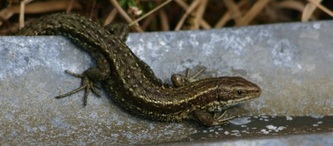
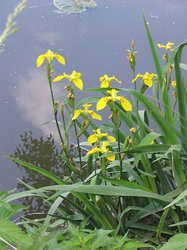
 RSS Feed
RSS Feed